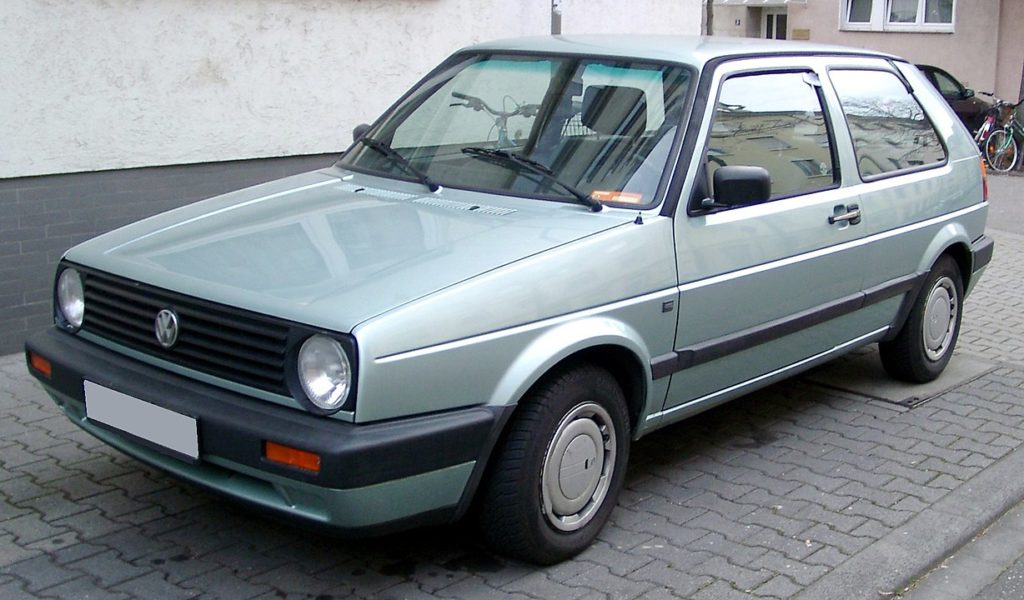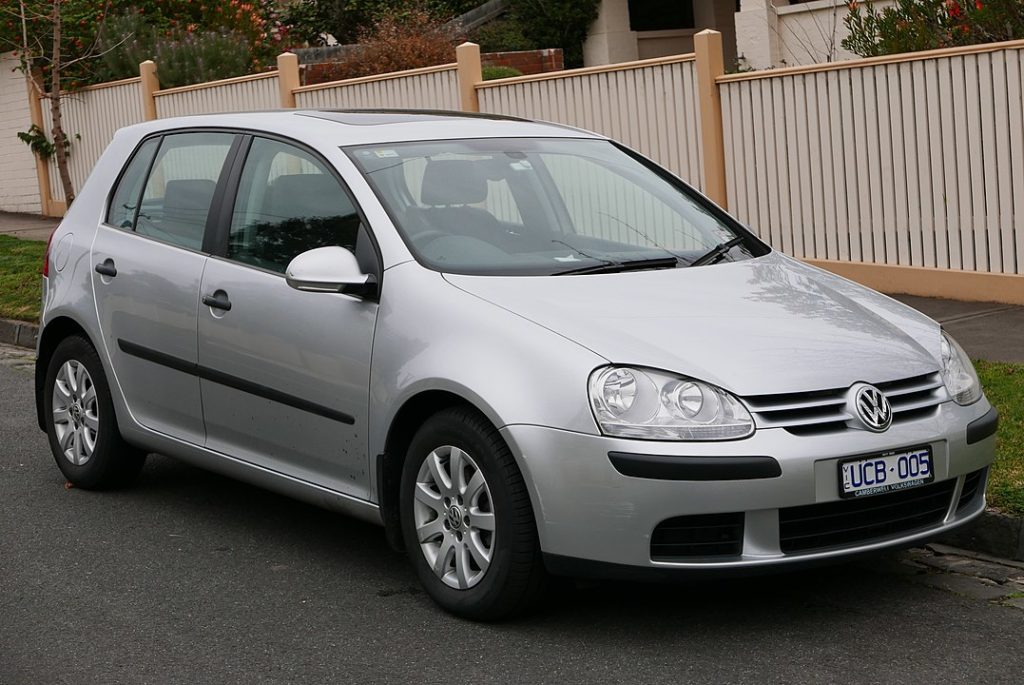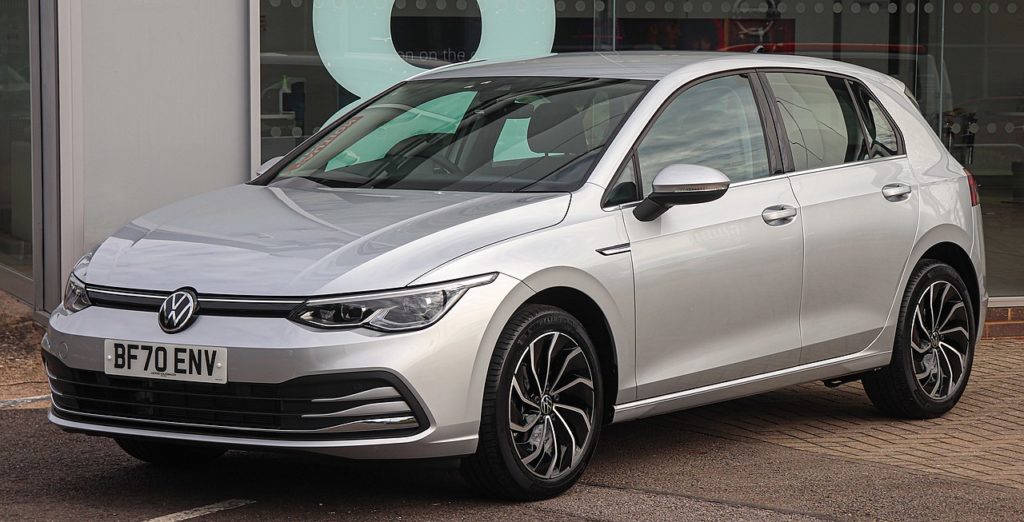In Part One of this post, we looked at why Volkswagen needed the Golf, how it was designed, and how it turned around VW’s fortunes. But what happened after the Mk1?
To answer that, instead of painstakingly picking through each model, we’ve picked three themes that we hope show how our expectations about cars have changed over the years. Then we’ll look at whether the Golf has managed to stay a people pleaser.
Size

It’s no secret that cars are getting bigger over time — in fact, one of the first things you notice about cars from yesteryear is how teeny-weeny they are.
The Golf has definitely reflected that trend. The original Mk I measured 145.9 inches by 63.4 (yes, we’re old school!) After its nine year run, one of the most noticeable things about the successor was how much bigger it was: the Mk 2 added 11 inches in length and was 2 inches wider. By the time the Mk 6 hit the market, it had grown to 165.5 inches, and the Mk 8 is 168.7 inches by 70.4.
So over its 48 year evolution, the Golf has stretched by a massive 2 feet and got 7 inches wider. Now that’s inflation! Still for comparison, look at how the Mini has evolved – the original looks like it would fit in the boot of a modern one.
Along with that increase in dimensions has come the inevitable weight gain — although, of course, a lot of added weight also comes from additional safety features and electrical gubbins.
The size of that increase is an eye-opener. Going for the lightest variant in each case, the Mk1 tipped the scales at a svelte 790kg. Wikipedia’s figures show that the Mk2 actually lost weight and was down to 725kg.
But fast forward to 2005 and the rot had set in: the Model V was a lardy 1164kg. With the Mk6, that was up to 1217kg. The Mk8 weighs in at 1255kg.
In its 48 year lifespan, the Golf has packed on 465kg, the weight of four really big hombres. It’s now 59% heavier than the first production model.
Technical features

Over its long life, the Golf has acquired a host of tech features. They give us an interesting picture of how the car market as a whole has evolved. Let’s pick a few out.
- The Mk2 Golf saw the first appearance of catalytic converters. They were available on petrol models from 1984 and diesel models from 1989. Post-emissions scandal, it now seems ironic that in the 1980s, VW led the pack on cleaning up exhausts.
- In 1991, the Mk3 introduced a direct injection diesel option. In TDI engines, the fuel is injected directly into the combustion chamber rather than a pre-combustion chamber, and a turbo is used to compress the intake air. The net result is much greater efficiency and hence fuel economy. VW weren’t quite the first to use this technology — Fiat had got there a few years before — but they made it their own (and branded it with the TDI label).
- By the 1990s, the Golf Mk4 was able to offer more sophisticated transmission options. A 6 speed gearbox was available from 1998, the R32 offered a DSG gearbox, and the Golf 4MOTION had all-wheel drive.
- In the 2000s, the Golf Mk5 is another technical leap up: the DSG now has seven speeds and petrol models get the world’s first twincharger system. The latter combines a supercharger and turbo for greater response and power: the 1.4 litre variant won 2010’s International Engine of the Year Award. Oh, and it got rain sensors too.
- From 2008, the Mk6 started to feature the assistive tech we’re now familiar with, including hill start assist, start-stop systems, parking assistance and more.
Safety features
This may seem a weird one to pick out in the Golf’s evolution, but remember that the model is first and foremost a family hatchback — so having the latest safety features has been essential for its survival.
When you look back at the first model, it’s a bit of a safety shocker, with very little beyond brakes and seatbelts. However, things started improving in the Mk2, which had anti-lock brakes (ABS). In 1992, things took another leap forward as the Golf Mk3 now had front airbags. The body was also redesigned to cope better with crashes. The Mk4 was another leap forward, with Electronic Stability Control appearing. In 2003, the Mk5 added rear side airbags, and the Mk6 now protected your knees with another airbag, helping it achieve five stars in the EuroNCAP crash tests,.
Twenty years on and the Mk8 has all sorts of electronic malarkey that we couldn’t have predicted in 1975, including (according to Parker’s):
- Car2X communications – this allows the Golf to communicate with other similarly-equipped cars and infrastructure to relay details of hazards such as accidents, jams and slippery conditions in order to give drivers even greater warning.
- Travel Assist – VW’s latest iteration of its driver-assistance system means the adaptive cruise control and lane-keeping system is even more reliable and now requires drivers to merely touch – rather than hold – the wheel while it’s in operation.
- Adaptive cruise control with predictive speed detection – using the existing system, but embellishing it with the ability to adapt speed based on mapping data and speed limit signs automatically.
- Turn-off assist – designed to apply the brakes when crossing the flow of traffic, as you would at a crossroads. If the car senses an impending impact, the Golf will automatically brake to avoid a crash altogether or reduce the severity of it.
The Mk8 may not have the simple rustic charm of the original, but my goodness, we know which one we’d rather be in if things went wrong.

